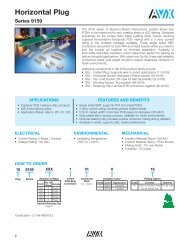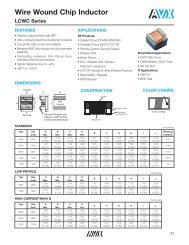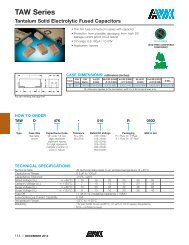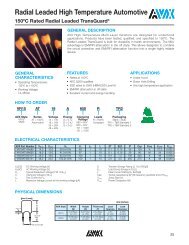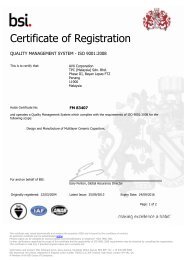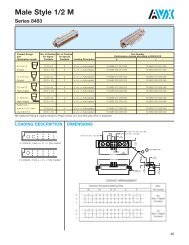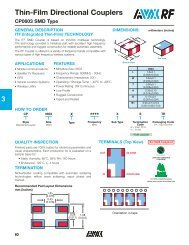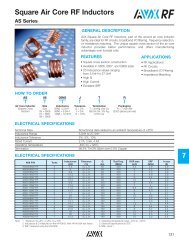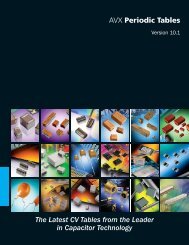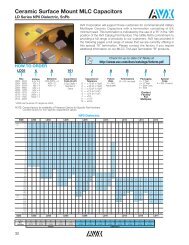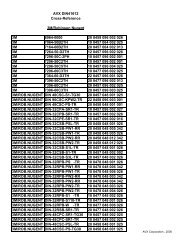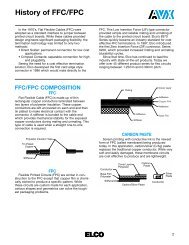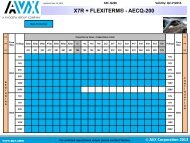TECHNICAL INFORMATION - AVX
TECHNICAL INFORMATION - AVX
TECHNICAL INFORMATION - AVX
You also want an ePaper? Increase the reach of your titles
YUMPU automatically turns print PDFs into web optimized ePapers that Google loves.
<strong>TECHNICAL</strong><br />
<strong>INFORMATION</strong><br />
FACTORS RESPONSIBLE FOR<br />
THERMAL SHOCK BEHAVIOR<br />
OF CHIP CAPACITORS<br />
By Bharat S. Rawal,<br />
Richard Ladew and<br />
Ricardo Garcia<br />
Abstract:<br />
Thermal shock behavior of multilayer ceramic chip<br />
capacitors was evaluated for different ceramic<br />
dielectrics with varying construction and design<br />
considerations, effects of terminations and role of<br />
physical defects to decrease the thermal stresses and<br />
decrease failure rates. Parameters such as thermal<br />
diffusivity including surface heat transfer coefficient,<br />
elastic modulus and thickness of chips are used to<br />
explain the results. A secondary goal of this evaluation<br />
was to identify the significant wave soldering<br />
parameters which could be utilized to eliminate the<br />
thermal shock failures of these chips.
I. Introduction<br />
FACTORS RESPONSIBLE FOR<br />
THERMAL SHOCK BEHAVIOR<br />
OF CHIP CAPACITORS<br />
The study of mechanical properties and thermal<br />
shock resistance parameters of multilayer ceramic<br />
capacitors (MLCs) is becoming increasingly important<br />
because of their increase in surface mount applications.<br />
A brief description of various aspects of this<br />
complex subject is given in the following paragraphs<br />
and some of the important factors are experimentally<br />
evaluated in this paper, a first in a series of papers to<br />
be devoted to this important subject. The obvious<br />
approach appears to be to consider the different<br />
sources of stresses possible in these devices, and then<br />
study the critical stress intensity factors and slow subcritical<br />
crack growth to obtain the critical stresses the<br />
devices can tolerate above which deleterious flaws<br />
result. This will allow us to study various aspects of<br />
the surface mount applications.<br />
A. Complexities of the MLC itself:<br />
As described earlier, 1 this monolithic device consists<br />
of barium titanate based dielectric ceramics<br />
with interleaved layers of palladium or palladiumsilver<br />
alloys, and a termination which consists of<br />
Pd/Ag alloys and/or a nickel barrier and a solder<br />
coating. This device is mounted on a substrate with<br />
or without epoxy and all these materials have a<br />
wide spectrum of thermal expansion coefficients<br />
and these are listed in Table 1. Residual stresses<br />
MATERIAL<br />
TABLE 1<br />
CTEs (ppm/°C)<br />
Barium Titanate Based Ceramics 9.5-11.5<br />
Pd/Ag Alloys 13-17<br />
Tin Lead Alloys 27<br />
Nickel 13-14<br />
Copper 17.6<br />
Alumina 7<br />
FR-4/G-10 PCB<br />
(in x-y directions only)<br />
18<br />
Polyimide Glass PCB<br />
(in x-y directions only)<br />
12<br />
Polyimide Kevlar PCB<br />
(in x-y directions only)<br />
7<br />
Epoxy Adhesives 20-100<br />
and other mechanical properties like elastic modulus<br />
and hardness have been studied 2 on polished<br />
sections of MLCs utilizing fracture mechanics<br />
By Bharat S. Rawal,<br />
Richard Ladew and<br />
Ricardo Garcia<br />
analysis based on the propagation of mutually perpendicular<br />
penny-like median/radial cracks using<br />
the Vicker’s micro-indentation techniques, and by<br />
indentation-biaxial fracture techniques for inert<br />
strength measurements. 3,4 These residual stresses<br />
by themselves are expected 2 to make only a small<br />
contribution to the overall stress state in these<br />
devices compared to the thermal stresses.<br />
B. Thermal Stresses<br />
When ceramics are subjected to a rapid change<br />
in temperature (such as plunging MLCs in a solder<br />
bath) stresses result because the surface reaches the<br />
new temperature instantly and the interior either<br />
remains at the initial temperature or, in most practical<br />
cases, there is a temperature gradient. For<br />
various geometries with parabolic temperature<br />
distributions where the average temperature is<br />
intermediate between the surface and center<br />
temperature, the corresponding stress s is found to<br />
be such that<br />
s ∆T (1)<br />
where ∆T is the temperature difference between<br />
the surface and center of a sample. This may be<br />
rewritten as<br />
s = E Søt 2 (2)<br />
(1-) (k/ C p )<br />
where E is the elastic modulus, is the coefficient<br />
of linear thermal expansion, s is the shape factor (s<br />
is 0.33 for a plate and 0.221 for a cube), ø is the rate<br />
of change of temperature, t is, for example, the half<br />
thickness for a plate, is Poisson’s ratio and (k/ C p )<br />
is the thermal diffusivity with k, and C p being the<br />
thermal conductivity, density and specific heat<br />
respectively. It is realized that for an MLC we are<br />
really dealing with a composite of metal-ceramic<br />
layers, and anisotropy of various parameters listed<br />
in equation (2) is expected; these aspects will be discussed<br />
in a later paper. 6 As equation (2) suggests<br />
and as a number of analytical studies have shown. 7-9<br />
materials with low E, low and low along with<br />
high thermal diffusivity are desirable. Equation (2)<br />
and these studies also clearly demonstrate that,<br />
when comparing materials or processes, lower rates<br />
of change of temperature and especially thinner<br />
geometries (because of the square dependence on<br />
the thickness) are desirable.<br />
Aside from the thermal conductivity k, another<br />
parameter which must be considered in heat transfer<br />
studies and corresponding thermal stresses in<br />
materials, is the surface heat transfer coefficient, h.<br />
This parameter changes rapidly with the surface<br />
characteristics of materials and it increases with<br />
improving contact between the two media across<br />
which the heat transfer takes place. Because of a<br />
temperature gradient surface stresses result in the<br />
material and this stress is proportional to h/k.
Now that the thermal stress has been identified,<br />
its effect on crack initiation and crack propagation<br />
should be recognized. Both these processes are<br />
important for the thermal stress or thermal shock<br />
resistance of ceramic materials.<br />
1. Crack Initiation<br />
The effect of thermal stresses on different<br />
materials 3,5 depends not only on stress level,<br />
stress distribution and stress duration but also<br />
on material characteristics such as ductility,<br />
homogeneity, porosity and pre-existing flaws.<br />
Because of so many characteristics involved in<br />
the thermal stress evaluations, it is impossible to<br />
define a single thermal stress resistance factor<br />
which is satisfactory for various situations.<br />
Most electronic ceramic materials behave like<br />
ideal elastic materials which fracture when the<br />
surface stress reaches a particular level. For<br />
conditions mentioned above the thermal stress<br />
resistance factor R’ is defined in Equation 3:<br />
R’ = k f (1-) (3)<br />
E<br />
where f is the fracture stress. This equation<br />
suggests that high fracture stress, low modulus<br />
of elasticity and low thermal expansion coefficient<br />
indicate a good resistance to thermal stress<br />
failure. Once again by considering the failure<br />
criterion of fracture occurring when the thermal<br />
stress reaches the fracture stress, it is possible to<br />
estimate the maximum temperature difference<br />
which a sample can withstand and this temperature<br />
difference is directly proportional to R’ and<br />
inversely proportional to half sample thickness t<br />
and to the surface heat transfer coefficient h.<br />
The above discussion is predicated on the<br />
assumption that failure occurs when the thermal<br />
stress reaches the fracture stress. It should,<br />
however, be noted that this condition is for the<br />
nucleation or initiation of cracks only. These<br />
stresses may be initiated at a surface but may be<br />
stopped by a pore, a heterogeneity or a grain<br />
boundary. These features will be qualitatively<br />
studied in the experimental section of this paper<br />
where various dielectric materials subjected to<br />
similar thermal stresses behave quite differently.<br />
2. Crack Propagation<br />
The conditions which govern the propagation<br />
of cracks rather than the nucleation are<br />
related 8,9 to the elastic energy stored at the<br />
moment of fracture. There are two thermal<br />
shock resistance parameters 8,9 which are<br />
involved in the avoidance of catastrophic crack<br />
propagation and they show a direct proportionality<br />
to the elastic modulus E, to the surface fracture<br />
energy G and inverse dependence to f2 .<br />
Thus the favorable material characteristics for<br />
crack propagation are high modulus and high<br />
surface fracture energy and low fracture<br />
strengths, in direct contrast to conditions<br />
appropriate for avoiding the initiation of cracks.<br />
In most electronic ceramic materials conditions<br />
for avoiding crack initiation are emphasized<br />
because micro-cracks may have a deleterious<br />
effect on other properties like the electrical conductivity.<br />
This is in strong contrast to, for example,<br />
porous refractory ceramic materials where<br />
large stress gradients initiate many surface<br />
cracks which are stopped primarily by pores,<br />
grain boundaries or metal layers. These stress<br />
relief sites are therefore important for high<br />
temperature stress corrosion resistance.<br />
C. Critical Fracture Toughness<br />
Critical stresses which the ceramic materials can<br />
withstand can be determined by fracture mechanics<br />
analysis of micro-indentations based on propagation<br />
of mutually perpendicular penny-like<br />
median/radial cracks. When an indentation is put<br />
on the sample using the Vicker’s indenter, the net<br />
driving force in the crack system is a result of two<br />
superimposed components (an elastic component<br />
and a residual component) which are compressive<br />
and tensile respectively. The residual component<br />
drives the crack to its final size when the indenter<br />
is removed and the restraining elastic component<br />
results in a well-defined crack which can be measured<br />
under an optical microscope. This technique<br />
provides a means to determine critical fracture<br />
toughness,<br />
E 1/2 P<br />
(4)<br />
K1 C<br />
0.013<br />
( H ) ( Co<br />
3/2)<br />
where H is the Vicker’s hardness, P is the applied<br />
load and C o is the equilibrium crack length in an<br />
isotropic material measured soon after the indentation.<br />
The corresponding critical stress at which a<br />
crack is initiated is:<br />
C = K1 C<br />
/y C o (5)<br />
where y = 2 / π<br />
The critical stress may be anisotropic in a MLC<br />
because of residual stresses which can be determined<br />
by studying the deviation and anisotropy of<br />
the measured crack lengths. In the study of slow<br />
crack growth, the underlying assumption is that<br />
these cracks will propagate when the stress intensity<br />
in the crack tip reaches the value corresponding<br />
to K1 C<br />
. An exponent in describing the crack<br />
velocity related to the fracture toughness can be<br />
defined 3 and this allows comparison of different<br />
dielectric materials. These results will be discussed<br />
in a later paper .6<br />
II. Experimental Procedure<br />
In an effort to understand the various sources of<br />
thermal stresses and corresponding thermal stress<br />
resistance characteristics, various experiments were<br />
carried out and these are outlined below:<br />
A. Ceramic Formulations<br />
Since different materials show varying susceptibility<br />
to similar thermal shock experiments,<br />
chips were fabricated using standard capacitor<br />
manufacturing techniques 1 with various dielectric<br />
compositions classified by EIA temperature characteristics<br />
referred to as NP0, X7R and Z5U<br />
ceramics. Even within the same temperature<br />
characteristic such as an X7R there are various<br />
ceramics used and the differences are minor additives<br />
referred to as fluxes which change the sintering<br />
temperatures of these materials. Various<br />
materials used for experiments are listed in Table
2. Several materials listed in this table are only<br />
experimental and are utilized for understanding<br />
the thermal shock behavior.<br />
TABLE 2<br />
TEMP. BASE MINOR FLUX<br />
CERAMIC DESIG. COMPOSITION ADDITIVES K 1C, CERAMIC<br />
A NP0 RARE EARTH OXIDE YES 1.4<br />
B NP0 MAGNESIUM TITANATE NO 1.5<br />
C X7R BARIUM TITANATE YES 1.1<br />
D X7R BARIUM TITANATE YES 1.2<br />
E X7R BARIUM TITANATE NO 0.6-0.8<br />
F Z5U BARIUM TITANATE NO 0.85<br />
G Z5U BARIUM TITANATE NO —<br />
B. Design Considerations<br />
Samples were prepared from ceramics ‘A’<br />
through ‘F’ (listed in Table 2) to study the effects<br />
of design changes in the 1206 size MLCs. This was<br />
done by changing the number and placement of<br />
electrode layers while the overall chip thickness<br />
was held constant. Both bridged designs,<br />
where the electrode stack is separated by a thick<br />
ceramic layer in the middle referred to as a<br />
“bridge”, and non-bridged designs were utilized to<br />
make the chips. MLCs (1206 size) were also made<br />
with electrode thicknesses of 3.3m and 5.5m by<br />
using different screen mesh sizes.<br />
C. Effect of Chip Thickness<br />
Since thermal stresses are known to change as a<br />
function of the square of unit thickness and are also<br />
dependent on the coefficient of thermal expansion,<br />
chips were prepared with varying thicknesses from<br />
0.38mm to 1.52mm for 1206, 1210 and 1812 size chips<br />
from ceramic D using non-bridged designs only.<br />
D. Effect of Dielectric Thickness<br />
As mentioned earlier, these devices are really<br />
metal-ceramic composites and varying the dielectric<br />
thickness should change the effective thermal<br />
conductivity and therefore the stress gradients<br />
in these chips. This effect was studied by preparing<br />
1210 size chips using ceramic D with constant cover<br />
layer and overall thicknesses, but varying dielectric<br />
thicknesses from 25 to 229 microns.<br />
E. Effect of Termination<br />
Another technique to change the thermal<br />
stresses and stress gradients is to utilize different<br />
types of terminations like Pd/Ag alloys or silver<br />
which is plated with nickel and a 90Sn/10Pb<br />
solder coating. The nickel thickness during the<br />
plating process is maintained at 2.0 ± 0.5 microns<br />
except for experiments where the effect of plating<br />
thickness of Ni was evaluated and the average<br />
thickness was varied from 1.5 to 18.4 microns.<br />
F. Role of Flaws<br />
Samples with various flaws like delaminations<br />
or cracks identified in chips prepared with<br />
ceramic G were tested for thermal shock resistance<br />
where thirteen groups with varying degree<br />
of flaws were studied.<br />
G. Thermal Stress Resistance and Wave Solder<br />
Conditions<br />
Of the four basic soldering processes (hot air<br />
reflow, infrared reflow, vapor phase reflow and wave<br />
soldering), it appears that wave soldering results in<br />
the largest temperature gradients and therefore the<br />
largest stress gradients. To simulate this process,<br />
two test conditions were utilized to evaluate chips<br />
studied in experimental procedures (A) through (F).<br />
In the first test condition (known as the solder dip<br />
test), chips were picked with metal tweezers along<br />
the ceramic edges of the chip and dipped in<br />
60Sn/40Pb solder at 260° and/or 425°C with no preheat<br />
such that either of the termination ends enters<br />
the solder and the chip is vertical. The tweezer is<br />
dipped in chloroethane, VG after each test to keep<br />
the tweezer at room temperature. In the second<br />
case, the chips were mounted on a board and a wave<br />
soldering temperature of 260°C was used. The wave<br />
soldering technique was further evaluated and setup<br />
parameters like the preheat and the speed of the<br />
board through the preheat and into the solder wave<br />
were varied. In all these cases, the chips were visually<br />
examined for cracks and these results are<br />
reported and discussed below. Several lots were also<br />
sectioned and polished to examine differences<br />
between external visual cracks and internal cracks<br />
and it was found that in general most cracks<br />
emerged at the surface. Correlation between various<br />
samples considering combined internal and<br />
external cracks, and only external cracks were found<br />
to be similar in behavior. For this reason, only external<br />
cracks were utilized in subsequent experiments.<br />
These results are reported and discussed below.<br />
III. Results and Discussion<br />
The various experiments listed above are now discussed<br />
in the following paragraphs.<br />
A. Behavior of Ceramic Dielectrics<br />
As indicated earlier, various ceramic dielectric<br />
materials behave quite differently under similar<br />
thermal shock experiments. Dielectric compositions<br />
classified by their temperature coefficients as NP0,<br />
X7R and Z5U were utilized to prepare 1206 size<br />
chips with various active layers and overall thicknesses<br />
of 0.85mm and 1.15mm, respectively. The<br />
results of the solder dip test of parts dipped in<br />
60Sn/40Pb solder at 260°C did not show any visual<br />
cracks. To study differences in the various ceramic<br />
materials, parts with Pd/Ag terminations were<br />
dipped in 60Sn/40Pb solder at 425°C with no preheat<br />
and the results are shown in Table 3. The<br />
results show:
TABLE 3<br />
THERMAL SHOCK STUDIES OF 1206 SIZE CHIPS<br />
WITH Pd/Ag TERMINATION<br />
OVERALL CHIP THICKNESS 33 (0.85) 45 (1.15)<br />
IN MILS (mm)<br />
NO. OF ELECTRODES WITH 0 2 4 8 16 24 NO .0 24 NO<br />
NO BRIDGE COVER COVER<br />
LAYERS LAYERS<br />
GREEN SOLDER DIP TEST RESULTS<br />
DIELECT. AT 425°C (800°F), NO PREHEAT<br />
ELECT. THICK. (Number of units with visual cracks in percent)<br />
CERA- THICK. IN MILS<br />
MIC (m) (m)<br />
A 3.3 1.6 (41) 0 0 0 0 0 0 0 0 0 0<br />
3.0 (76) 0 0 0 0 0 0 0 0 0 0<br />
5.5 1.6 (41) 0 0 0 0 0 0 0 0 0 0<br />
3.0 (76) 0 0 0 0 0 0 0 0 0 0<br />
B 5.5 3.0 (76) 0 0 0 0 0 0 0 0 0 0<br />
C 3.3 1.6 (41) 0 21 1 1 0 0 0 0 0 3<br />
2.4 (61) 0 33 2 0 0 0 0 0 0 0<br />
5.5 1.6 (41) 0 9 0 0 0 0 0 0 0 0<br />
2.4 (61) 0 6 0 0 0 0 0 0 0 0<br />
D 3.3 1.4 (36) 6 41 20 5 2 0 0 4 3 2<br />
E 3.3 1.4 (36) 0 0 0 3 90 0 0 0 96 3<br />
F 3.3 1.5 (38) 1 0 1 6 12 9 0 0 17 0<br />
1. NP0 Chips (Ceramics A and B) have excellent<br />
thermal shock resistance with none of the units<br />
showing any visual cracks. This is attributed to<br />
their relatively higher critical stress intensity<br />
factors of about 1.4 MPam 1/2 which prevents crack<br />
initiation and to the two phase pyrochlore<br />
microstructure of these materials which slows<br />
crack propagation as evidenced by the partial<br />
intergranular nature of the fracture along with<br />
various crack deflection sites in these ceramics. 3<br />
Ceramic A also has minor additives added as<br />
fluxes which form additional grain boundary and<br />
other phases which in turn further slow down<br />
the crack propagation. These aspects will be<br />
discussed further in our next paper.<br />
2. X7R Materials (Ceramics C and D) show an<br />
anomalous behavior where the ceramic itself<br />
exhibits no cracks and parts with high number of<br />
electrodes show no visual cracks. However, parts<br />
made with 2 to 16 electrodes develop many visual<br />
cracks with a 3.3m electrode thickness, and<br />
fewer with a 5.5m electrode thickness. This<br />
behavior is not exhibited by ceramic E in the<br />
same table, even though this is an X7R material<br />
as well. The behavior of ceramics C and D is<br />
characteristic of X7R materials prepared with<br />
minor fluxing additives which contain bismuth.<br />
Pd is known to diffuse into the ceramic and the<br />
remaining electrode is richer in Ag which in turn<br />
results in formation of Bi-Ag-Pd based alloys<br />
leaving porous electrodes. The corresponding<br />
ceramic cavities act as crack initiation sites<br />
resulting in thermal shock failures. This problem<br />
can be minimized by higher density modified<br />
electrodes and practically eliminated by the<br />
bridge designs discussed below.<br />
3. Ceramics E and F show higher number of visual<br />
cracks with high active MLCs. These are<br />
attributed to physical flaws which are discussed<br />
later.<br />
B. Design Considerations<br />
It was just demonstrated that X7R parts with<br />
2-16 electrodes with no bridge show a significant<br />
number of visual cracks. Chips (size 1206) with<br />
2-16 electrodes with a “bridge” are tested under<br />
TABLE 4<br />
THERMAL SHOCK STUDIES OF 1206 SIZE CHIPS WITH BRIDGE DESIGN<br />
AND Pd/Ag TERMINATION<br />
OVERALL CHIP THICKNESS 33 (0.85)<br />
IN MILS (mm)<br />
NO. OF ELECTRODES 0 2 4 8 16<br />
WITH A BRIDGE<br />
CERAMIC GREEN SOLDER DIP TEST RESULTS AT 425°C<br />
DIELECTRIC (800°F), NO PREHEAT (NUMBER OF<br />
THICKNESS IN UNITS WITH VISUAL CRACKS IN<br />
MILS (m) PERCENT)<br />
A 1.6 (41) 0 0 0 0 0<br />
3.0 (76) 0 0 0 0 0<br />
C 1.5 (38) 0 0 0 0 0<br />
2.4 (61) 0 0 0 0 0<br />
similar conditions and Table 4 shows that NP0 parts<br />
once again show excellent thermal shock resistance<br />
while X7R parts show a dramatic improvement.<br />
The improvement is attributed to the reduction of<br />
temperature gradients and corresponding stress<br />
gradients in these chips due to a relatively higher<br />
effective thermal conductivity near the surface of<br />
these chips because of the presence of electrodes.<br />
This aspect will be evaluated further in section (D)<br />
below.<br />
To evaluate the bridge design further, 1210 X7R<br />
0.1F parts are tested with and without a bridge<br />
and similar overall chip thickness, and these results<br />
are shown in Table 5; the parts with a bridge definitely<br />
show an improvement with lower number of<br />
visual cracks in the solder dip test. The overall chip<br />
thickness can be used to further improve the parts<br />
and this is discussed in the next section.<br />
TABLE 5<br />
THERMAL SHOCK STUDIES OF CERAMIC AS AFFECTED BY DESIGN<br />
OF CHIP 1210 X7R 0.1F, PLATED<br />
OVERALL CHIP THICKNESS 33 46 46<br />
IN MILS (mm) (0.85) (1.17) (1.17)<br />
SOLDER DIP TEST RESULTS AT 260°C<br />
(500°F), NO PREHEAT<br />
CHIP DESIGN 25A/35T* 25A/48T 25A/48T<br />
NO BRIDGE BRIDGE NO BRIDGE<br />
DESIGN<br />
LOT #<br />
1 6 21 63<br />
2 5 15 22<br />
3 7 13 31<br />
4 12 18 30<br />
5 2 11 20<br />
X = 6.4 15.6 33.2<br />
*A STANDS FOR ACTIVE LAYERS, T IS THE TOTAL NUMBER OF<br />
CERAMIC LAYERS<br />
C. Effect of Chip Thickness<br />
As discussed in the theoretical section of this<br />
paper, thermal stresses depend on the square of the<br />
overall chip thickness; therefore, this parameter is<br />
very important in the chip design and subsequent<br />
thermal shock behavior. The 1210 X7R 0.1F parts<br />
with an overall chip thickness of 1.17mm were<br />
redesigned with an overall chip thickness of<br />
0.85mm, and the solder dip test results at 260°C in<br />
Table 5 clearly demonstrate that the visual cracks<br />
were further reduced by more than half to about<br />
6.4%. This is expected as the thermal stresses are<br />
reduced by about 85%.<br />
To evaluate the effect of chip thickness further,<br />
various commonly used chip styles were prepared<br />
with thicknesses ranging from 0.38mm to 1.52mm.
TABLE 6<br />
EFFECT OF THICKNESS ON THERMAL SHOCK OF<br />
CERAMIC D PLATED CHIPS<br />
OVERALL CHIP THICKNESS IN MILS (mm)<br />
15 20 25 30 40 60<br />
(0.38) (0.51) (0.64) (0.76) (1.01) (1.52)<br />
CHIP STYLE SOLDER DIP TEST RESULTS AT 260°C<br />
(500°F), NO PREHEAT<br />
1206 0 0 0 0 2 3<br />
1210 0 0 0 1 2 24<br />
1812 0 0 0 2 11 41<br />
The solder dip test results, shown in Table 6, once<br />
again confirm that as the thicknesses increase the<br />
number of visual cracks increase. It should be further<br />
noted that, in general for thick parts at a constant<br />
chip thickness, as the part size increases the visual<br />
cracks increase and this is not surprising because<br />
larger geometries have larger stresses resulting<br />
from thermal mismatch between ceramic and electrode<br />
layers for the same temperature change.<br />
This information is being utilized to make optimum<br />
geometries for similar valued parts by <strong>AVX</strong>.<br />
D. Effect of Dielectric Thickness<br />
Chips were prepared with constant overall chip<br />
and cover layer thicknesses and the ceramic dielectric<br />
layer thickness was varied from 25 to<br />
229m. These results, shown in Table 7, demonstrate<br />
that the effective thermal conductivity of the<br />
composite increases as the dielectric thickness<br />
decreases which in turn decreases the temperature<br />
and stress gradients and the corresponding number<br />
of visual cracks. This experiment further supports<br />
the use of the bridge design for low active parts as a<br />
viable alternative.<br />
TABLE 7<br />
THERMAL SHOCK FAILURES AS A FUNCTION<br />
OF DIELECTRIC THICKNESS<br />
CERAMIC D, 1210 CHIPS WITH 40 MIL (1.02mm) OVERALL THICKNESS,<br />
TERMINATED AND SOLDER PLATED<br />
DIELECTRIC SOLDER DIP TEST RESULTS AT 260°C (500°F),<br />
THICKNESS NO PREHEAT<br />
IN MILS<br />
(NUMBER OF UNITS WITH VISUAL CRACKS<br />
(m)<br />
IN PERCENT)<br />
1.0 (25) 2<br />
2.0 (51) 17<br />
3.0 (76) 18<br />
4.0 (101) 16<br />
5.0 (127) 19<br />
9.0 (229) 49<br />
E. Effect of Termination<br />
As indicated earlier, termination materials play a<br />
very important role in the thermal shock behavior<br />
of MLCs. Chips made with Pd/Ag termination<br />
materials and with Ag termination which is subsequently<br />
plated with nickel and solder, and then subjected<br />
to the solder dip test show dramatic differences.<br />
An example of this behavior is shown in Table 8<br />
where 1210 size 0.1F chips made with ceramic D<br />
show no visual cracks with Pd/Ag terminations but<br />
the same parts with Ag termination which is plated<br />
with about 2.0m of nickel and 4.0m of solder<br />
show cracks in practically 100% of the parts.<br />
TABLE 8<br />
ROLE OF TERMINATION IN THERMAL SHOCK STUDIES<br />
1210 CHIPS 0.1 F CERAMIC C, 61 MILS (1.55mm) OVERALL THICKNESS<br />
Pd/Ag Ag termination Ni Barrier Ni Barrier Ni Barrier<br />
Termination with Ni Barrier parts, no parts heat parts heat<br />
and solder solder treated to treated at<br />
plated 160°C for 400°C for<br />
1 hr. 1 hr.<br />
Solder dip<br />
test results<br />
at 260°C, 0/200 199/200 100/100 70/100 0/100<br />
no preheat<br />
(number of<br />
units with<br />
visual cracks<br />
to total parts<br />
tested)<br />
These observations may be explained by the following<br />
analysis.<br />
Thermal conductivity data for Pd/Ag alloys or<br />
termination materials is not available but some<br />
estimates can be generated. Pd and Ag have<br />
thermal conductivity values of about 84 and 428<br />
Wm -1 °K - 1 respectively. 10 Typical Pd/Ag alloys are<br />
therefore expected to have values of around 200<br />
Wm -1 °K - 1 . However, most termination materials<br />
have glass frits added to improve adhesion of these<br />
materials to the MLC. Without going into the<br />
details of proprietary glass frit materials used for<br />
terminations, and utilizing average values of thermal<br />
conductivity for glasses of about 0.84 Wm -1 °K - 1<br />
along with the assumption that these glass frits<br />
form a grain boundary phase or are at the ceramictermination<br />
interface, the effective thermal conductivity<br />
can be calculated 11 to be somewhere between<br />
10 to 25 Wm -1 °K - 1 . No provision has been made for<br />
a small amount of porosity which may exist in the<br />
termination as the thermal conductivity of pores 11<br />
is around 0.02 Wm -1 °K - 1 and these values are<br />
expected to be lowered further to about 6-20<br />
Wm -1 °K - 1 . In contrast the nickel barrier is dense<br />
and nickel has a thermal conductivity of about 84<br />
Wm -1 °K - 1 which is about an order of magnitude<br />
higher. Aside from the differences in the thermal<br />
conductivities, it was observed during the solder<br />
dipping experiments that (even though both the<br />
Pd/Ag and plated barrier layer terminations wet<br />
well), the plated terminations wet much faster<br />
compared to the Pd/Ag terminated chips. This in<br />
turn implies that the surface heat transfer coefficient<br />
for the plated terminations is significantly<br />
higher compared to that for Pd/Ag parts. This<br />
nickel layer therefore transfers the heat at the<br />
termination rapidly resulting in larger stress gradients<br />
compared to parts with Pd/Ag termination<br />
only and these stress gradients result in 100% visual<br />
cracks in the solder dip test. To further illustrate<br />
the validity of this hypothesis, chips with a nickel<br />
barrier but no protective solder coating (customarily<br />
used) were oxidized at 160° and at 400°C respectively<br />
for 1 hour; solder dip test results are shown<br />
in Table 8. The results show a dramatic drop in the<br />
number of visual cracks after the solder dip test<br />
and this is attributed to an order of magnitude<br />
lower thermal conductivity of nickel oxide and to a<br />
significantly lower surface heat transfer coefficient<br />
of an oxide film. This demonstrates the importance<br />
of the role of the termination itself. The termination<br />
geometry has also been found to be a very important<br />
parameter which in turn controls the surface<br />
heat transfer coefficient and the subsequent visual<br />
cracks due to stress gradients. These aspects are<br />
utilized to control the thermal shock behavior of<br />
chips and will be discussed in the next paper. 6
To study the effect of the plating thickness on the<br />
termination, chips with various plating thicknesses<br />
as characterized by the plating time were tested<br />
and the results are shown in Table 9. For 1812 size<br />
chips, the actual plated nickel thicknesses are<br />
shown in brackets. The results clearly show that at<br />
Ni thicknesses above 4.8m failures in the solder<br />
dip test increase and these may be attributed to<br />
either stresses due to the differential thermal<br />
expansions of nickel and the chip or to residual<br />
stresses. This phenomenon is not clearly understood<br />
at this time.<br />
TABLE 9<br />
THERMAL SHOCK STUDIES VS. BARRIER LAYER THICKNESS<br />
FOR CERAMIC D<br />
PLATING TIME (MIN.)<br />
7.5 15 30 60 120<br />
CHIP DESIGN OVERALL SOLDER DIP TEST RESULTS AT 260°C<br />
STYLE (ACTIVES/ CHIP (500°F), NO PREHEAT (NUMBER OF<br />
TOTAL) THICKNESS UNITS WITH VISUAL CRACKS TO<br />
IN MILS TOTAL PARTS STUDIED)<br />
(IN MM)<br />
1206 24/43 44 (1.12) 1/50 0/50 0/50 0/50 2/50<br />
1210 32/49 61 (1.55) 0/50 3/50 2/50 5/50 5/50<br />
1812 32/39 40 (1.02) 1/50 1/50 0/50 5/50 5/50<br />
80* 160* 190* 340* 725*<br />
(2.03) (4.13) (4.80) (8.70) (18.41)<br />
*ACTUAL NI BARRIER LAYER THICKNESS IN MICROINCHES (MICRONS)<br />
F. Role of Flaws<br />
In Table 3, parts made with ceramic E and F<br />
with high number of active layers were found to<br />
show higher number of visual cracks after the<br />
solder dip test and these are attributed to numerous<br />
physical flaws in these parts. To investigate the<br />
effect of physical flaws, chips made with ceramic G<br />
were tested. In this case, parts were processed<br />
through various sintering conditions for a completely<br />
different series of evaluations; the corresponding<br />
flaws generated are listed in Table 10.<br />
TABLE 10<br />
THERMAL SHOCK BEHAVIOR AS AFFECTED BY<br />
PHYSICAL FLAWS OF CERAMIC G<br />
ALL UNITS WITH PD/AG TERMINATIONS<br />
SOLDER DIP TEST RESULTS<br />
AT 425°C, NO PREHEAT<br />
TYPES OF FLAW<br />
(NUMBER OF UNITS WITH<br />
GROUP # (% OF UNITS WITH FLAWS) VISUAL CRACKS AS %)<br />
External External External<br />
Delaminations Cracks Delaminations<br />
1 71 2 100 100<br />
2 44 - 85 95<br />
3 84 - 82 90<br />
4 18 - 40 86<br />
5 77 - 87 86<br />
6 37 - 49 81<br />
7 20 - 42 81<br />
8 49 - 76 76<br />
9 5 15 7 76<br />
10* - - - 52<br />
11 40 - 9 48<br />
12 - - - 5<br />
*THIS GROUP HAS POROUS ELECTRODES WHICH MAY ACT AS SITES<br />
FOR CRACK INITIATION<br />
There is only a general correlation between number<br />
of flaws and the solder dip test results. These flaws<br />
act as crack initiation sites. Results of group 10<br />
were at first misleading because apparently no<br />
flaws were found; however, closer examination<br />
revealed porous electrodes which have already been<br />
shown to act as sites for crack initiation.<br />
TABLE 11<br />
ROLE OF WAVE SOLDER PARAMETERS WITH WAVE TEMPERATURE<br />
OF 260°C (500°F) OF CERAMIC D<br />
ALL CHIPS ARE PLATED<br />
G. Soldering Considerations<br />
As indicated earlier, wave soldering was often<br />
used as a test vehicle to simulate the temperature<br />
and/or stress gradients in the chips studied. Two<br />
important parameters studied were the preheat<br />
temperature and the immersion rate of the part<br />
into the solder. Immersion rate was preferred over<br />
the actual temperature rise for the chips because it<br />
was impossible to read the temperature change<br />
accurately; this can be done by burying the thermocouple<br />
in the part, and the results of these experiments<br />
will be reported at a later date. The immersion<br />
rate is determined by the belt speed carrying<br />
the boards into the wave; a common rate of 1.22<br />
m/min. is used in the industry.<br />
The results of these experiments are shown in<br />
Table 11 where it is clearly seen that both the preheat<br />
and the immersion rate are critical to controlling<br />
the soldering process. Our recommendation is<br />
that the preheat temperature as measured on the<br />
board should be a maximum of 100°C below the<br />
temperature of the wave and the rate of immersion<br />
should be 1.2 m/min. Results in Table 11 show how<br />
these results may be optimized but since different<br />
ceramic materials show varying degrees of thermal<br />
shock susceptibility, the recommended conditions<br />
should be followed wherever possible.<br />
Conclusions<br />
BOARD TEST RESULTS (NUMBER<br />
OF UNITS WITH VISUAL CRACKS<br />
TO TOTAL UNITS TESTED)<br />
SOLDER CONDITIONS GROUP A GROUP B<br />
PREHEAT, IF BELT SPEED IN 1210, 01µF, 1210, 01µF,<br />
ANY (°C) FT/MIN (m/min) 25A/48T WITH 25A/35T, NO<br />
BRIDGE, 45 MILS BRIDGE, 33 MILS<br />
THICK<br />
THICK<br />
NONE 4 (1.2) 9/240 3/240<br />
20 (6.1) 51/240 6/240<br />
NONE 4 (1.2) 8/240 1/240<br />
20 (6.1) 41/240 2/240<br />
NONE 4 (1.2) 0/240 0/240<br />
10 (3.0) 15/240 1/240<br />
20 (6.1) 26/240 2/240<br />
1. Chips made from NP0 dielectric materials show<br />
excellent thermal shock behavior in surface mount<br />
applications.<br />
2. Chips made with 2-12 active layers from X7R<br />
dielectrics with bismuth containing additives may<br />
exhibit thermal shock failures if the electrodes are<br />
porous. This problem may be minimized with denser<br />
electrodes and with bridge designs.<br />
3. Bridge designs can dramatically improve thermal<br />
shock behavior exhibited by chips made with X7R<br />
dielectrics.<br />
4. Thickness of the chip plays a very important role<br />
in the overall chip design and visual cracks can be<br />
dramatically reduced with the decrease in overall<br />
chip thickness.
5. As the dielectric thickness increases, the susceptibility<br />
to thermal shock may increase for X7R<br />
dielectrics. This result supports the utilization of<br />
the bridge design as a viable technique to improve<br />
thermal shock behavior.<br />
6. Nickel barrier terminations show higher susceptibility<br />
to thermal shock compared to Pd/Ag terminated<br />
chips. The termination geometry becomes an important<br />
parameter and it may be used to reduce these<br />
failures; this will be discussed in the next paper.<br />
7. There is a general correlation between physical<br />
flaws and thermal shock susceptibility of chips.<br />
Physical flaws such as major delaminations and<br />
porous electrodes act as crack initiation sites.<br />
8. Both the preheat temperature and the immersion<br />
rate are very important in wave soldering techniques.<br />
A preheat temperature as measured on the<br />
board should be a maximum of 100°C below the<br />
temperature of the wave. A 1.2 m/min. immersion<br />
is recommended.<br />
References<br />
1. M. Kahn, “Multilayer Ceramic Capacitors -<br />
Materials and Manufacture,” <strong>AVX</strong> Technical<br />
Information Series, 1981, 5 pp.<br />
2. B. Wong, R. J. Holbrook, C. A. Megerle and L. E.<br />
Medina, “Microindentation for Mechanical<br />
Assessment of Microelectronic Components,”<br />
Proceedings of International Symposium on<br />
Microelectronics, ISHM 1986, pp 399-410.<br />
3. T. L. Baker and S. W. Freiman, “Fracture Behavior<br />
of Ceramics Used in Multilayer Capacitors,” in the<br />
Proceedings of the Third US-Japan Seminar on<br />
Dielectric and Piezoelectric Materials, Toyoma,<br />
Japan (1986).<br />
4. G. R. Anstis, P. Chantikul, B. R. Lawn and D. B.<br />
Marshall, “A Critical Evaluation of Indentation<br />
Techniques for Measuring Fracture Toughness: I,<br />
Direct Crack Measurements,” J. American Ceramic<br />
Society, 64 (9) 533-538; and “II, Strength Method,”<br />
ibid, 539-543.<br />
5. W. D. Kingery, H. K . Bowen and D. R. Uhlmann,<br />
Chapter 16 in “Introduction to Ceramics” John<br />
Wiley & Sons, Inc., New York (1976).<br />
6. B. S. Rawal, R. Garcia and R. Ladew, to be presented<br />
at the International Symposium on Microelectronics,<br />
ISHM 1987 in Minneapolis, MN.<br />
7. W. D. Kingery, “Factors Affecting Thermal Shock<br />
Resistance of Ceramic Materials,” J. American<br />
Ceramic Society, 38 (1) 3-15 (1955).<br />
8. D. P. H. Hasselman, “Unified Theory of Thermal<br />
Shock Fracture Initiation and Crack Propagation of<br />
Brittle Ceramics,” J. American Ceramic Society,<br />
52 (11) 600-604 (1969).<br />
9. D. P. H. Hasselman, “Thermal Stress Resistance<br />
Parameters for Brittle Refractory Ceramics: A<br />
Compendium,” American Ceramic Society Bull.,<br />
49 (12) 1933-37 (1970).<br />
10. CRC Handbook of Chemistry and Physics, Vol. 50,<br />
p. E10, published by The Chemical Rubber<br />
Company, Cleveland, OH 44128, (1970).<br />
11. W. D. Kingery, H. K. Bowen and D. R. Uhlmann,<br />
“Introduction to Ceramics,” p. 636-38 in Chapter<br />
12, John Wiley & Sons, Inc., New York (1976).<br />
NOTICE: Specifications are subject to change without notice. Contact your nearest <strong>AVX</strong> Sales Office for the latest specifications. All statements, information and data<br />
given herein are believed to be accurate and reliable, but are presented without guarantee, warranty, or responsibility of any kind, expressed or implied. Statements<br />
or suggestions concerning possible use of our products are made without representation or warranty that any such use is free of patent infringement and are not<br />
recommendations to infringe any patent. The user should not assume that all safety measures are indicated or that other measures may not be required. Specifications<br />
are typical and may not apply to all applications.<br />
© <strong>AVX</strong> Corporation<br />
<strong>AVX</strong> Myrtle Beach, SC<br />
Corporate Offices<br />
Tel: 843-448-9411<br />
FAX: 843-626-5292<br />
<strong>AVX</strong> Northwest, WA<br />
Tel: 360-699-8746<br />
FAX: 360-699-8751<br />
<strong>AVX</strong> North Central, IN<br />
Tel: 317-848-7153<br />
FAX: 317-844-9314<br />
<strong>AVX</strong> Mid/Pacific, MN<br />
Tel: 952-974-9155<br />
FAX: 952-974-9179<br />
USA EUROPE ASIA-PACIFIC<br />
<strong>AVX</strong> Southwest, AZ<br />
Tel: 480-539-1496<br />
FAX: 480-539-1501<br />
<strong>AVX</strong> South Central, TX<br />
Tel: 972-669-1223<br />
FAX: 972-669-2090<br />
<strong>AVX</strong> Southeast, NC<br />
Tel: 919-878-6223<br />
FAX: 919-878-6462<br />
<strong>AVX</strong> Canada<br />
Tel: 905-564-8959<br />
FAX: 905-564-9728<br />
<strong>AVX</strong> Limited, England<br />
European Headquarters<br />
Tel: ++44 (0) 1252 770000<br />
FAX: ++44 (0) 1252 770001<br />
<strong>AVX</strong> S.A., France<br />
Tel: ++33 (1) 69.18.46.00<br />
FAX: ++33 (1) 69.28.73.87<br />
<strong>AVX</strong> GmbH, Germany - <strong>AVX</strong><br />
Tel: ++49 (0) 8131 9004-0<br />
FAX: ++49 (0) 8131 9004-44<br />
<strong>AVX</strong> GmbH, Germany - Elco<br />
Tel: ++49 (0) 2741 2990<br />
FAX: ++49 (0) 2741 299133<br />
<strong>AVX</strong> srl, Italy<br />
Tel: ++390 (0)2 614571<br />
FAX: ++390 (0)2 614 2576<br />
<strong>AVX</strong> Czech Republic, s.r.o.<br />
Tel: ++420 (0)467 558340<br />
FAX: ++420 (0)467 558345<br />
<strong>AVX</strong>/Kyocera, Singapore<br />
Asia-Pacific Headquarters<br />
Tel: (65) 258-2833<br />
FAX: (65) 350-4880<br />
<strong>AVX</strong>/Kyocera, Hong Kong<br />
Tel: (852) 2-363-3303<br />
FAX: (852) 2-765-8185<br />
<strong>AVX</strong>/Kyocera, Korea<br />
Tel: (82) 2-785-6504<br />
FAX: (82) 2-784-5411<br />
<strong>AVX</strong>/Kyocera, Taiwan<br />
Tel: (886) 2-2696-4636<br />
FAX: (886) 2-2696-4237<br />
<strong>AVX</strong>/Kyocera, China<br />
Tel: (86) 21-6249-0314-16<br />
FAX: (86) 21-6249-0313<br />
<strong>AVX</strong>/Kyocera, Malaysia<br />
Tel: (60) 4-228-1190<br />
FAX: (60) 4-228-1196<br />
Elco, Japan<br />
Tel: 045-943-2906/7<br />
FAX: 045-943-2910<br />
Kyocera, Japan - <strong>AVX</strong><br />
Tel: (81) 75-604-3426<br />
FAX: (81) 75-604-3425<br />
Kyocera, Japan - KDP<br />
Tel: (81) 75-604-3424<br />
FAX: (81) 75-604-3425<br />
http://www.avxcorp.com<br />
S-FRTSB00M0900-C



